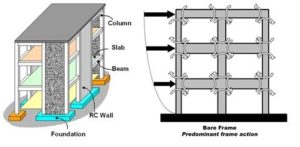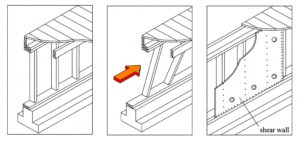What is Shear Wall? its Types

A shear wall is an RCC structural member used in a frame structure to resist the lateral forces develop by winds or seismic forces generated due to the earth quicks. These are the vertical member of the building structures. In the high rise buildings, we mainly use these walls.
The design of these walls is done according to the recommendation of the International residential code or International building code. These walls are constructed with materials such as (concrete, steel, bricks, wood, etc) and located in the parameter or center of the building, especially in the lift sections or some times in stairwell.
It starts from the foundation and ends at the top of the building. This type of wall is mainly used in (4 – 35) stories buildings. It thickens varies from 150 to 400 mm.
Forces acting on the shear wall:
There are two main forces which act on these walls,
Shear force
- The algebraic sum of all forces acting on either side of the section is termed as a shear force.
- Shear forces are produced in buildings from the ground movement and lateral forces like wind and waves.
Uplift forces
- This force produces due to the horizontal forces to the top of the shear wall.
- It tries to lift up the one end of the shear wall and push down to the other end of the wall.
- Uplift forces produce a greater effect on the tall walls and smaller effects on the low long wall.
Types of the shear wall:
Those are the most common types of these walls.
1: Concrete shear wall
This is the most common type of this walls.
- This wall consists of the reinforcements and concrete slab.
- The wall thickness of RCC varies from the 150mm to 400mm.
- The shear wall rebars start from the building foundation and end to the building top.
- Concrete is poured into the formworks and removes after the standard time of formwork removal.

2: Steel plate shear wall
The steel plate wall consists of steel plate walls and bounded by the columns and the boundary elements like columns and horizontal floor beams.
- The boundary column and the steel plate will act as the vertical plate girder.
- The steel plate wall acts as the web of the vertical plate girder and the column acts as the flanges of the vertical plate girder.
- After the reinforced foundation finished, the shear wall Anker bolts should be installed into the foundation reinforcement before pouring concrete.
- After this work, the column plates should be installed and level it by grout.

3: Plywood shear wall
These walls consist of the plywoods to distributes or transfer the shear forces.
- In the plywood, the steel-backed shear panel and sheet steel are used in the place of structural used plywood in the shear wall, which is stronger to resist seismic pressure.
- In small walls, we use plywood shear wall at either side of the opening in a shear wall.

4: RHCBM
RC hollow concrete wall masonry.
- RHCBM consists of reinforcement and a hollow concrete masonry block.
- These walls have the material advantage because they taking hollow space and shapes of the hollow blocks.
- We design these walls to counter lateral seismic loads and wind pressure and also work as a load-bearing walls for the gravity loads.

Purpose of constructing this wall:
We construct these walls to resist,
- The lateral loads of earthquakes and wind.
- The verticle or gravity loads on the structure.
- To make the structure more stable.
- The counter shear and uplift forces.
Location of the shear wall in buildings:
The location of the shear wall totally depends on the,
- Structure plan.
- Core location.
- Building symmetry.
- The lateral force experienced by the structure.
It is very difficult to find the best location for this wall. The most common and useful practice of the shear wall is in the center (Lift section) or in the parameter of the building. The location is decided after the complete structural analysis or case studies.
Design Considerations of the shear wall:
- The thickness of the wall is between 150 mm to 400 mm.
- The diameter of bars is between 1/10 of the wall thickness.
- Minimum reinforcement is 0.25% of the gross area of the section.
- Two curtain reinforcement is provided if
- The thickness of the wall exceeds 200 mm.
- Factored shear stress is increase (0.25√ƒck).
If you like this information, Shear it with your friends.
We Love CricketAdd a Comment
You must be logged in to post a comment.

1) is shear wall is feasible in sub structure or super structure which is more advantageous for the structure?
2) whether minimum thickness to be observed as per its span and height?
3) whether total structure to be provided with shear walls or corner walls are just enough?